
Reading Terminal Market
Encyclopedia
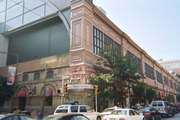
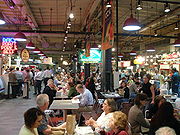
Public market
Public markets are markets, in public spaces, where independent merchants can sell their products to the public. Typical products sold at public markets include fresh produce and baked goods, locally raised meats and dairy products, and various other food items and handcrafted goods...
found at 12th and Arch Streets in downtown Philadelphia, Pennsylvania. Over one hundred merchants offer fresh produce, meats, fish, groceries, ice cream, flowers, baked goods, crafts, books, clothing, and specialty and ethnic foods. Every space in the market is rented out; three of the vendors are descendants of original market merchants. The market is open every day of the week (regular hours: M-Sat: 8am-6pm; Sun: 9am-5pm). The Pennsylvania Dutch
Pennsylvania Dutch
Pennsylvania Dutch refers to immigrants and their descendants from southwestern Germany and Switzerland who settled in Pennsylvania in the 17th and 18th centuries...
merchants (a small but significant minority) generally do not operate Sunday through Tuesday.
Structure
The Reading Terminal Market occupies the ground floor and basement levels of the Reading TerminalReading Terminal
The Reading Terminal is a complex of buildings located in the Market East section of Center City in the city of Philadelphia, Pennsylvania, United States...
's former train shed, now part of the Philadelphia Convention Center. Market stalls occupy the ground floor with entrances on Filbert Street to the south, Twelfth Street to the West, and Arch Street to the North. The stalls are arranged in a grid pattern with an open area in the center with tables and seating. It is full of many different kinds of ceiling fans.
The Market was one of the first to feature a state-of-the-art refrigerated
Refrigeration
Refrigeration is a process in which work is done to move heat from one location to another. This work is traditionally done by mechanical work, but can also be done by magnetism, laser or other means...
storage area in the basement. The basement storage area consists of 52 separate rooms ranging in volume from 5,000 to 17,000 cubic feet (141,500 to 481,200 Liters) for a total of a half-million cubic feet (14+ million Liters) of storage space . The temperature of each room can be controlled individually to meet temperature requirements for different goods: 15 °F (-9.4 °C) to 25 °F (-3.9 °C) for meat and poultry, 34 °F (1.1 °C) for fruits and vegetables. The refrigeration system uses brine water and ammonia and includes an array of specially designed pumps, compressors, and other equipment in its operation.
Origins
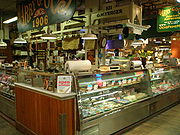
Delaware River
The Delaware River is a major river on the Atlantic coast of the United States.A Dutch expedition led by Henry Hudson in 1609 first mapped the river. The river was christened the South River in the New Netherland colony that followed, in contrast to the North River, as the Hudson River was then...
ran for six blocks, or one full mile, prompting the main street (then called 'High Street') to be renamed 'Market Street
Market Street (Philadelphia)
Market Street, originally known as High Street, is a major east–west street in Philadelphia, Pennsylvania. For the majority of its length, it serves as Pennsylvania Route 3....
.' Soon after the markets reached their peak growth and capacity, open-air markets within the city became seen as dirty and unhygienic by the public. The frenzy of activity along the main street was seen as a nuisance and traffic hazard. In 1859, city officials bowed to public pressure and dismantled all of them. This prompted two indoor markets to open at 12th and Market Streets, Franklin Market and Farmers' Market. These two would be the foundation of the Reading Terminal Market.
Expansion and growth
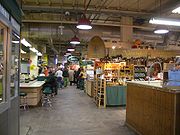
Industrial Revolution
The Industrial Revolution was a period from the 18th to the 19th century where major changes in agriculture, manufacturing, mining, transportation, and technology had a profound effect on the social, economic and cultural conditions of the times...
brought with it the expansion of the railroad, and great palatial urban terminals sprang up in major cities. The Reading Railroad's headhouse terminal was designed by architect F. H. Kimbal of the Wilson Brothers Architecture & Engineering firm in 1891, and opened in 1893. The rails were elevated to reach the train shed platform built over top of the new consolidated market, which opened a year earlier. George McKay was chosen to be the Market's first superintendent while the building was undergoing its final phase of construction.
The state-of-the-art refrigerated
Refrigeration
Refrigeration is a process in which work is done to move heat from one location to another. This work is traditionally done by mechanical work, but can also be done by magnetism, laser or other means...
storage area in the basement opened for use in July 1893. The storage area was more expensive to maintain and had a larger staff than the market itself. The area was so involved as to require its own superintendent, George McKay's brother Edwin "Nash" McKay. Refrigerating the basement storage area was thought to be well worth the high cost. It allowed merchants to keep seasonal products on stock all year round for the first time. The storage area was also leased out to third parties for storing other goods. Restaurants and plant and produce sellers around the area leased out space in the basement. Hospitals used the basement area to store perishable medicine. Local Breweries, including Yuengling , used it to store their hops
Hops
Hops are the female flower clusters , of a hop species, Humulus lupulus. They are used primarily as a flavoring and stability agent in beer, to which they impart a bitter, tangy flavor, though hops are also used for various purposes in other beverages and herbal medicine...
.
In its first few decades, the Reading Terminal Market was a success. There were 380 merchants in the first year of operations, and the market had nearly full occupancy for the following 60 years. Business, already good, flourished with the innovation of a free "market basket service", which allowed suburban housewives to place a grocery order and have it delivered to their nearest train station, where it would be held so that they could pick it up at their earliest convenience. Refrigerated trucks allowed the market to reach into some 60 suburban towns as well as seaside resorts along the New Jersey
New Jersey
New Jersey is a state in the Northeastern and Middle Atlantic regions of the United States. , its population was 8,791,894. It is bordered on the north and east by the state of New York, on the southeast and south by the Atlantic Ocean, on the west by Pennsylvania and on the southwest by Delaware...
shore.
Decline and rebirth
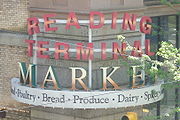
Great Depression
The Great Depression was a severe worldwide economic depression in the decade preceding World War II. The timing of the Great Depression varied across nations, but in most countries it started in about 1929 and lasted until the late 1930s or early 1940s...
of the 1930s brought hardship to the Market. By the late 1930s, merchants were under increasing pressure from the AFL
American Federation of Labor
The American Federation of Labor was one of the first federations of labor unions in the United States. It was founded in 1886 by an alliance of craft unions disaffected from the Knights of Labor, a national labor association. Samuel Gompers was elected president of the Federation at its...
and CIO
Congress of Industrial Organizations
The Congress of Industrial Organizations, or CIO, proposed by John L. Lewis in 1932, was a federation of unions that organized workers in industrial unions in the United States and Canada from 1935 to 1955. The Taft-Hartley Act of 1947 required union leaders to swear that they were not...
to join their respective labor unions. This led to a series of strikes that further disrupted business. The introduction and proliferation of supermarkets also hurt Market Business during the 1930s. One of these new establishments opened across on the other side of 12th street, directly competing with the Reading Market. Pressure to compete with supermarkets led to fewer stalls being run by farmers, and more being run by middle men reselling a variety of goods .
Despite the turmoil brought on by the depression and new competition, the Reading Terminal Market remained afloat during the 1930s. By some accounts, the Market did rather well. According to George H. Eltien, then superintendent, the Market was shipping phone orders to 38 states, Canada, and Mexico throughout the decade . Pressure from supermarkets was not hurting all of the merchants. Ten of the market's 64 merchants had been there since its founding in 1892. In 1930, the Reading Terminal Market Merchants Association was formed in an effort to promote and advertise the market and avoid losing business. The Association was responsible for several promotional events including the first annual Food Show and Home Progress Exhibitions. It also helped to fund a 1934 renovation of the Market's facade that installed new electric lights and window decorations.
America's involvement in World War II during the 1940s affected the Market primarily in a positive way. In 1944, the most economically straining year of the war, the Market was at 97 percent occupancy. Food shortages brought on by the war increased the demand for the Market's goods. On May 9, 1946, the Reading Terminal Market experienced its largest recorded crowd . Over 12,000 people gathered at the market to purchase meat, poultry, and pork products that were unavailable elsewhere due to shortages.
The suburbanization of America and decline of the railroads in the 1950s and 1960s severely affected the market. The market began running on a deficit in 1954, and by 1959 was only 70 percent occupied, forcing Reading to raise rents . The state-of-the-art cold storage facility was shut down and dismantled, forcing tenants to supply their own. Several other events hurt the Market and its merchants financially. The Dock Street wholesale market was closed and demolished as part of the urban renewal
Urban renewal
Urban renewal is a program of land redevelopment in areas of moderate to high density urban land use. Renewal has had both successes and failures. Its modern incarnation began in the late 19th century in developed nations and experienced an intense phase in the late 1940s – under the rubric of...
program in Society Hill
Society Hill, Philadelphia, Pennsylvania
Society Hill is a neighborhood in the Center City section of Philadelphia, Pennsylvania, United States. The neighborhood, loosely defined as bounded by Walnut, Lombard, Front and 7th Streets, contains the largest concentration of original 18th- and early 19th-century architecture of any place in...
. This hurt many resellers at the Reading Market who depended on the Dock Street market for supplies . On January 16, 1960, a four alarm fire broke out in the Reading Terminal's powerhouse, causing power outages that led to lost business and spoiled food.
The railroad company filed for bankruptcy in 1971, and ceased to function as a railroad company in 1976. The company continued to serve mainly as a real estate business, but paid little attention to the managing and promoting of the market, and pondered ways to get rid of the market so that it would be easier to sell the terminal building .

Pennsylvania Convention Center
The Pennsylvania Convention Center is a multi-use public facility in Philadelphia, Pennsylvania which is designed to accommodate conventions, exhibitions, conferences and other events.-History:...
Authority (PCCA), and in 1994, Philadelphia City Council established a new, non-profit Reading Terminal Market Corporation to operate the market. The Reading Terminal Market Corporation and the PCCA continued the revitalization program begun by the Reading Company, recruiting new tenants and increasing promotion of the market. By the mid-1990s to the 2000s, the market was once again living up to its founders' vision. Over 90% of its leasable space is occupied by profitable and stable vendors. (ABC News, October 28, 2005) Since October 2006, the Market has been open on Sundays as part of a "trial" program that has been extended twice. (Hefler, October 16, 2006) The market is currently open 7 days a week, but not all vendors are open on Sundays. The Pennsylvania Dutch vendors are open Wednesday through Saturday.
The market's place in Philadelphia

Liberty Bell
The Liberty Bell is an iconic symbol of American Independence, located in Philadelphia, Pennsylvania. Formerly placed in the steeple of the Pennsylvania State House , the bell was commissioned from the London firm of Lester and Pack in 1752, and was cast with the lettering "Proclaim LIBERTY...
. It is adjacent to two Marriott Hotels, a Hilton Garden Inn
Hilton Garden Inn
Hilton Garden Inn is a chain of hotels trademarked by the Hilton Worldwide. Hilton Garden Inns are considered to be upscale mid-priced hotels that are designed for both business and leisure travelers. The hotel brand is similar to that of the Courtyard by Marriott brand, a key competitor...
, the Pennsylvania Convention Center, SEPTA's Market East Station, the Philadelphia Greyhound Terminal
Philadelphia Greyhound Terminal
The Philadelphia Greyhound Terminal is the primary intercity bus station in Philadelphia, Pennsylvania. It is located at 1001 Filbert Street in Center City Philadelphia, immediately north of The Gallery at Market East shopping mall and the SEPTA Market East Station, a few hundred feet east of the...
, and another Philadelphia landmark, The Gallery at Market East
The Gallery at Market East
The Gallery at Market East, or "The Gallery" as it is known to locals, is an urban mall in downtown Philadelphia, Pennsylvania, United States with over 130 stores and a food court. The mall's major anchor stores are Kmart and Burlington Coat Factory....
mall. (gophila.com, 1998–2007)
Philbert the pig, a sculpture by Eric Berg, is the Market's mascot and donations made to this 'piggy bank' go to support healthy eating programs at The Food Trust (gophila.com, 1998–2007)
The market was a filming location for several major motion pictures including Trading Places
Trading Places
Trading Places is a 1983 American comedy film, of the satire genre, directed by John Landis, starring Dan Aykroyd and Eddie Murphy. It tells the story of an upper class commodities broker and a homeless street hustler whose lives cross paths when they are unknowingly made part of an elaborate bet...
and National Treasure
National treasure
The idea of national treasure, like national epics and national anthems, is part of the language of Romantic nationalism, which arose in the late 18th century and 19th centuries. Nationalism is an ideology which supports the nation as the fundamental unit of human social life, which includes shared...
.

